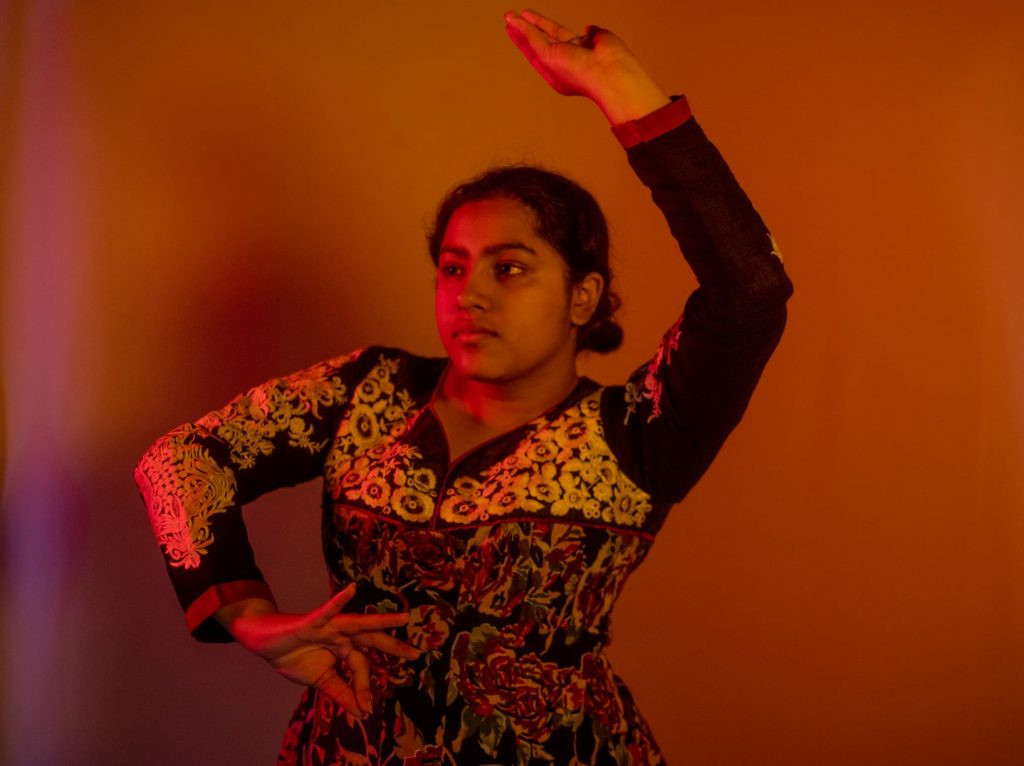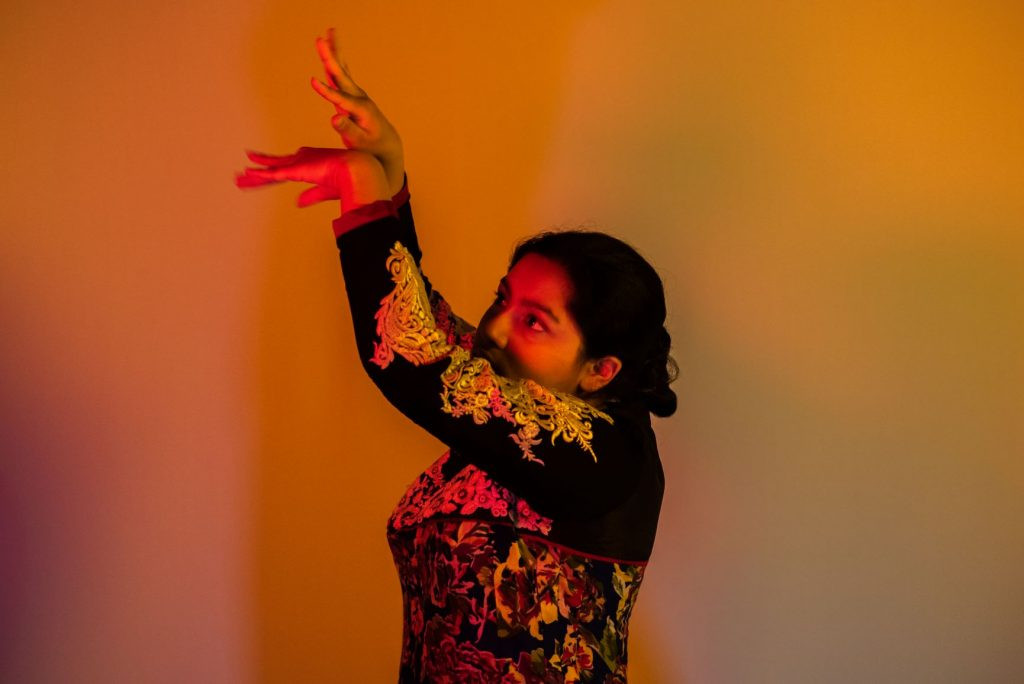From a young age, the vibrant world of dance captivated me. Starting at six, I embarked on a self-taught dance journey, drawing inspiration from television, movies, and online platforms like YouTube. This exploration led me to discover and learn various dance styles, ranging from the passionate rhythms of salsa to the energetic beats of Bhangra, the dynamic moves of hip hop, and the graceful forms of classical Indian Dance.
While I embraced the diversity of global dance genres, my heart resonated most deeply with Indian dances, particularly Bhangra, belly dance, and the intricate world of classical forms. Among these, Kathak holds a special place as my favorite classical Indian dance. Kathak, a prominent and ancient dance form hailing from Northern India, has become a central part of my dance expression.
 Kathak dancer in a poised stance, showcasing the elegance of Indian classical dance.
Kathak dancer in a poised stance, showcasing the elegance of Indian classical dance.
Recently, while browsing YouTube, I stumbled upon a captivating Bollywood dance video promoting an upcoming movie. Intriguingly, the dance style featured was Kathak, one of the eight major forms of Indian classical dance. This sparked a deeper reflection on the pervasive influence and diverse nature of Indian dance within popular culture.
It’s important to understand that Bollywood, while often associated with a specific dance style, is actually a film industry encompassing a wide array of genres – from horror and comedy to romance – and a vast spectrum of dance styles. These extravagant musical movies incorporate nearly every imaginable dance form.
Indian films showcase a rich tapestry of dance styles, often in fusion or pure forms, including Kathak, Bharatnatyam, Odissi, Garba, and Bhangra. Beyond indigenous styles, they also embrace international dances like belly dance, Latin, hip hop, contemporary, jazz, and countless others, reflecting a globalized and dynamic approach to movement.
Personally, Kathak has presented the most significant learning curve within classical Indian dance forms. It remains a continuous journey of refinement. The complexity of Kathak lies in the simultaneous coordination of intricate hand movements and footwork. However, the true essence of Kathak, and perhaps its greatest challenge, lies in mastering facial expressions. A proficient Kathak dancer must embody expressiveness, channeling emotions and narratives through subtle nuances of the face.
 Expressive Kathak performance, illustrating the storytelling aspect of Indian dance through hand gestures.
Expressive Kathak performance, illustrating the storytelling aspect of Indian dance through hand gestures.
Yet, Kathak transcends mere physical movement; it is deeply rooted in storytelling. The term “Kathak” originates from the Sanskrit word “Katha,” meaning “story,” and “Kathakar,” denoting “storyteller.” The origins of Kathak can be traced back to ancient times, between 500 BCE and 500 CE, where it flourished in Hindu temples as a powerful medium for narrating epic tales and mythologies from Hindu scriptures.
A Kathak performance is a multi-sensory experience, weaving together dance, song, and music to unfold narratives, much like an opera. Dancers use their hand gestures (mudras), rhythmic footwork, and evocative facial expressions to bring stories to life, often depicting tales of the Hindu god Krishna or legendary epics like the Ramayana.
Over time, Kathak’s influence extended beyond temple confines. Nomadic Kathakars, or musical storytellers, disseminated the dance form across the country, broadening its reach and accessibility. Consequently, Kathak evolved from a style exclusive to Kathakars to a dance form embraced by diverse populations worldwide. This wider accessibility, facilitated by platforms like Bollywood movies and music videos, allowed individuals like myself to engage with and learn Kathak.
Interestingly, Kathak’s appeal transcends religious boundaries. While deeply connected to Hindu traditions, Muslim communities have also embraced and contributed to this dance form. This cultural confluence is reflected in the costumes, with both Hindu and Muslim communities incorporating elements of their respective attire. Hindu female Kathak dancers often wear a sari in a distinctive style, paired with a choli (short blouse) or a more covering blouse and scarf. Another common costume features a long, embroidered skirt with a contrasting choli. Male Kathak dancers typically don a silk dhoti (loincloth) with a silk scarf draped across the upper body, which may be bare or covered by a loose jacket.
Jewelry plays a significant role in the female Kathak dancer’s attire, typically gold ornaments adorning the hair, nose, ears, and hands. Crucially, every Kathak dancer requires ghunghru, dance anklets made of leather straps adorned with small metallic bells. These are fastened around the ankles, producing rhythmic sounds that accentuate the dancer’s intricate footwork.
 Ghunghru anklets on a Kathak dancer's feet, highlighting the rhythmic footwork and musicality of Indian dance.
Ghunghru anklets on a Kathak dancer's feet, highlighting the rhythmic footwork and musicality of Indian dance.
Recently, I invested in my own ghunghru, a purchase I made after saving diligently. Dancing with them is a joyous experience; the multitude of bells creates a vibrant sound, so resonant that my mother can hear them even from upstairs in our house!
I find immense joy in Kathak’s global accessibility. While mastering it presents challenges, the rewards are substantial. Kathak is not only a fulfilling exercise but also a powerful medium for emotional expression and creative exploration through choreography. My personal connection to Kathak stems from its capacity to channel emotions and foster creativity.
For anyone seeking to explore a new dance form, I wholeheartedly recommend Kathak. Despite the initial learning curve, the journey is enriching. Kathak has instilled in me patience, expressiveness, and creativity. Furthermore, it has provided a profound avenue to engage with and appreciate Indian culture beyond passive observation.
Embarking on the Kathak journey is an invaluable opportunity to actively immerse oneself in Indian culture and heritage. Kathak offers a path to spiritual connection and introspection, allowing dancers to articulate life’s joys and sorrows. This ability to communicate through dance, to convey emotions more powerfully than words, is at the heart of Kathak’s enduring appeal and significance within Indian dance traditions.
